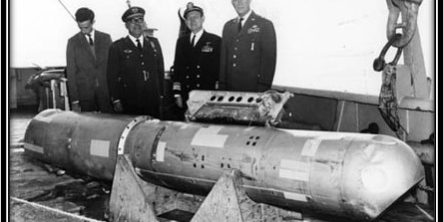On This Day: “Broken Arrow”
Contributor: Barry Fetzer
Sources: History.com
We are a flawed species, we Homo sapiens, are we not? We act before we think and say things we ought not to say and tweet things we ought not to write (and then fruitlessly attempt to delete them). We fail far too often to engage our brains before putting our mouths in gear. We habitually allow our emotions to control our lives rather than, us, our emotions. We think of ourselves too much and others too little. We’re skilled at being the proverbial “pot calling the kettle black”, judging others while blind to our own faults.
Amongst our many failures and faults, though, there are also sacred, Godly sparks in each of us.
One of those sacred sparks, blessedly, must be pure, unadulterated luck. With all our imperfections and failures, we should have by now blown ourselves back to pre-creation or, if not that far back, at least “back to the Stone Age” as US Air Force General Curtis LeMay famously quipped in speaking about what our strategy should be, “bomb ‘em back to the Stone Age”, in speaking about his strategy for defeating the North Vietnamese.
Why is it that those God-fired sparks must include luck? Because even though we’ve tried to blow ourselves back to the Stone Age dozens of times since we let the nuclear genie out of the bottle, we haven’t succeeded. Still, our own, self-created nuclear Armageddon has been far closer than many of us know.

Courtesy History.com
Take the following “Broken Arrow” (as the USAF names these incidents) from 58 years ago for instance:
Today, January 17th in 1966, according to History.com, “a B-52 bomber collided with a KC-135 jet tanker over Spain’s Mediterranean coast, dropping three 70-kiloton hydrogen bombs near the town of Palomares and one in the sea. It was not the first or last accident involving American nuclear bombs.

B-52 over Vietnam photo courtesy Pinterest
“As a means of maintaining first-strike capability during the Cold War, U.S. bombers laden with nuclear weapons circled the earth ceaselessly for decades. In a military operation of this magnitude, it was inevitable that accidents would occur. The Pentagon admits to more than three-dozen accidents in which bombers either crashed or caught fire on the runway, resulting in nuclear contamination from a damaged or destroyed bomb and/or the loss of a nuclear weapon. One of the only ‘Broken Arrows’ to receive widespread publicity occurred on January 17, 1966, when a B-52 bomber crashed into a KC-135 jet tanker over Spain.
“The bomber was returning to its North Carolina base following a routine airborne alert mission along the southern route of the Strategic Air Command when it attempted to refuel with a jet tanker. The B-52 collided with the fueling boom of the tanker, ripping the bomber open and igniting the fuel. The KC-135 exploded, killing all four of its crew members, but four members of the seven-man B-52 crew managed to parachute to safety. None of the bombs were armed, but explosive material in two of the bombs that fell to earth exploded upon impact, forming craters and scattering radioactive plutonium over the fields of Palomares. A third bomb landed in a dry riverbed and was recovered relatively intact. The fourth bomb fell into the sea at an unknown location.
“Palomares, a remote fishing and farming community, was soon filled with nearly 2,000 U.S. military personnel and Spanish civil guards who rushed to clean up the debris and decontaminate the area. The U.S. personnel took precautions to prevent overexposure to the radiation, but the Spanish workers, who lived in a country that lacked experience with nuclear technology, did not. Eventually some 1,400 tons of radioactive soil and vegetation were shipped to the United States for disposal.
“Meanwhile, at sea, 33 U.S. Navy vessels were involved in the search for the lost hydrogen bomb. Using an IBM computer, experts tried to calculate where the bomb might have landed, but the impact area was still too large for an effective search. Finally, an eyewitness account by a Spanish fisherman led the investigators to a one-mile area. On March 15, a submarine spotted the bomb, and on April 7 it was recovered. It was damaged but intact.

Eighty days after it fell into the ocean following the January 1966 midair collision between a nuclear-armed B-52G bomber and a KC-135 refueling tanker over Palomares, Spain, this B28FI nuclear bomb was recovered from 2,850 feet (869 meters) of water and lifted aboard the USS Petrel (note the missing tail fins and badly dented “false nose”). This photograph was among the first ever published of a U.S. hydrogen bomb. Left to right are Sr. Don Antonio Velilla Manteca, chief of the Spanish Nuclear Energy Board in Palomares; Brigadier General Arturo Montel Touzet, Spanish coordinator for the search and recovery operation; Rear Admiral William S. Guest, commander of U.S. Navy Task Force 65; and Major General Delmar E. Wilson, commander of the Sixteenth Air Force. The B28 had a maximum yield of 1.45 megatons.
U.S. Navy photo courtesy of the Natural Resources Defense Council.
“Studies on the effects of the nuclear accident on the people of Palomares were limited, but the United States eventually settled some 500 claims by residents whose health was adversely affected. Because the accident happened in a foreign country, it received far more publicity than did the dozen or so similar crashes that occurred within U.S. borders. As a security measure, U.S. authorities do not announce nuclear weapons accidents, and some American citizens may have unknowingly been exposed to radiation that resulted from aircraft crashes and emergency bomb jettisons. Today, two hydrogen bombs and a uranium core lie in yet undetermined locations in the Wassaw Sound off Georgia, in the Puget Sound off Washington, and in swamplands near Goldsboro, North Carolina.”







